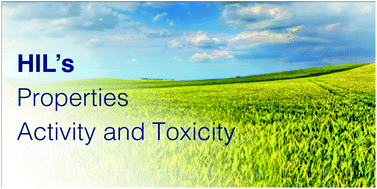Herbicidal ionic liquids based on esterquats†
Abstract
Novel herbicidal ionic liquids (HILs) containing different anions and cations derived from ammonium esterquats were prepared by employing a simple, inexpensive pathway. The basic physicochemical properties of the synthesized salts (such as density, viscosity, refractive index, solubility and thermal stability) were determined. Additionally, their herbicidal efficacy was evaluated under greenhouse and field conditions with a subsequent assessment of biodegradability and toxicity (acute oral toxicity towards rats and rainbow trout, the growth inhibition test of green algae and the acute immobilization test using water flea). The results of greenhouse and field experiments revealed that the herbicidal activity of HILs comprising long alkyl chains has exceeded that of commercial plant protection products. The HIL containing the di(tallowoyloxyethyl)dimethylammonium cation exhibited notable biodegradability (63% after 28 days) and various toxicity classifications depending on the tested organism: category V towards rats with LC50 > 2000 mg, category II towards fish with LC50/96 h at 10.62 mg L−1, category I towards algae and daphnids with ErC50/72 h at 1.73 mg L−1 and EC50 at 0.28 mg L−1, respectively. These findings provide evidence that the synthesis of HILs with a specifically designed structure may be successfully employed for obtaining novel, efficient and environmentally friendly plant protection agents.


 Please wait while we load your content...
Please wait while we load your content...